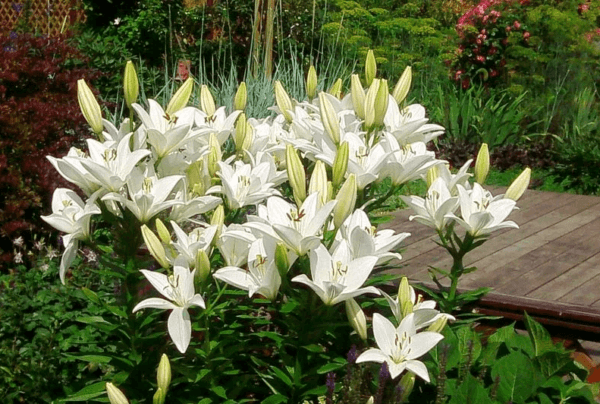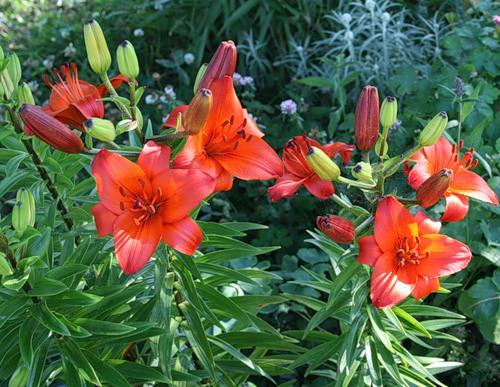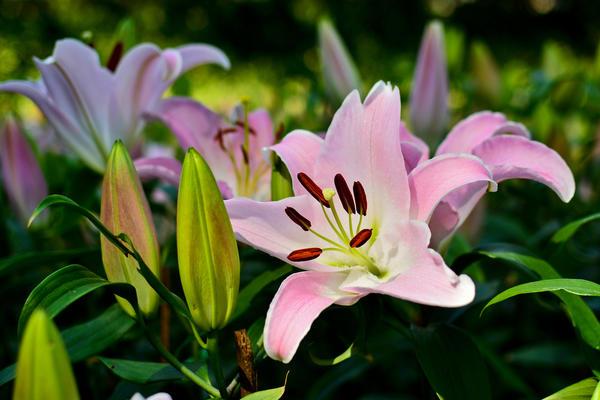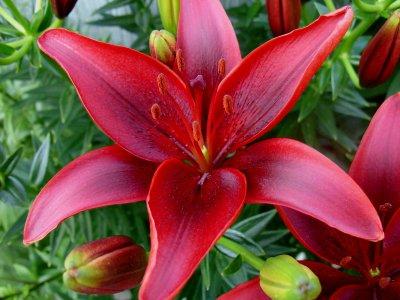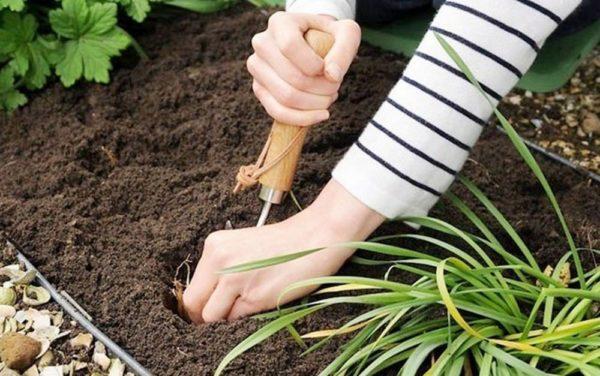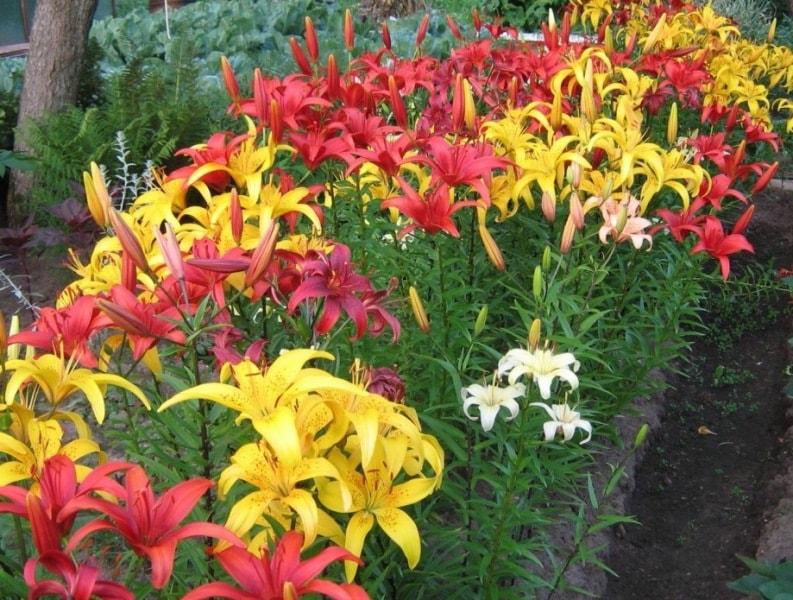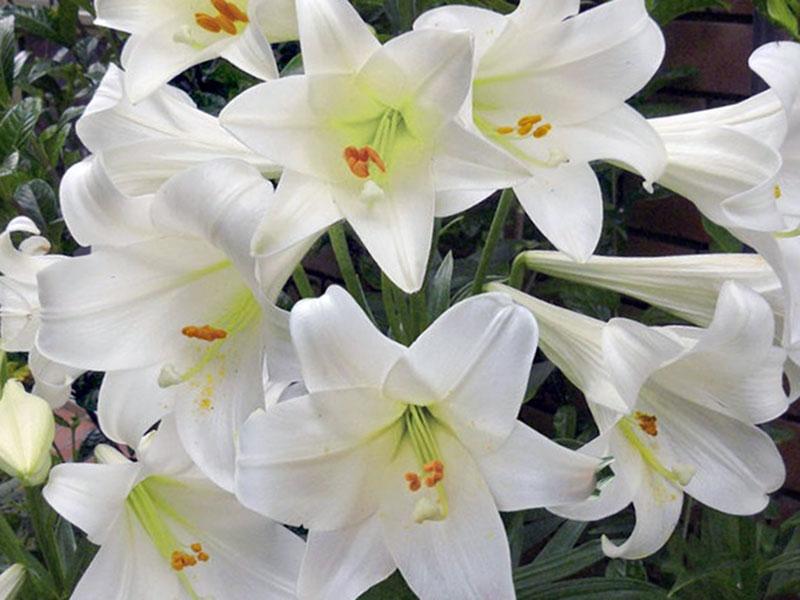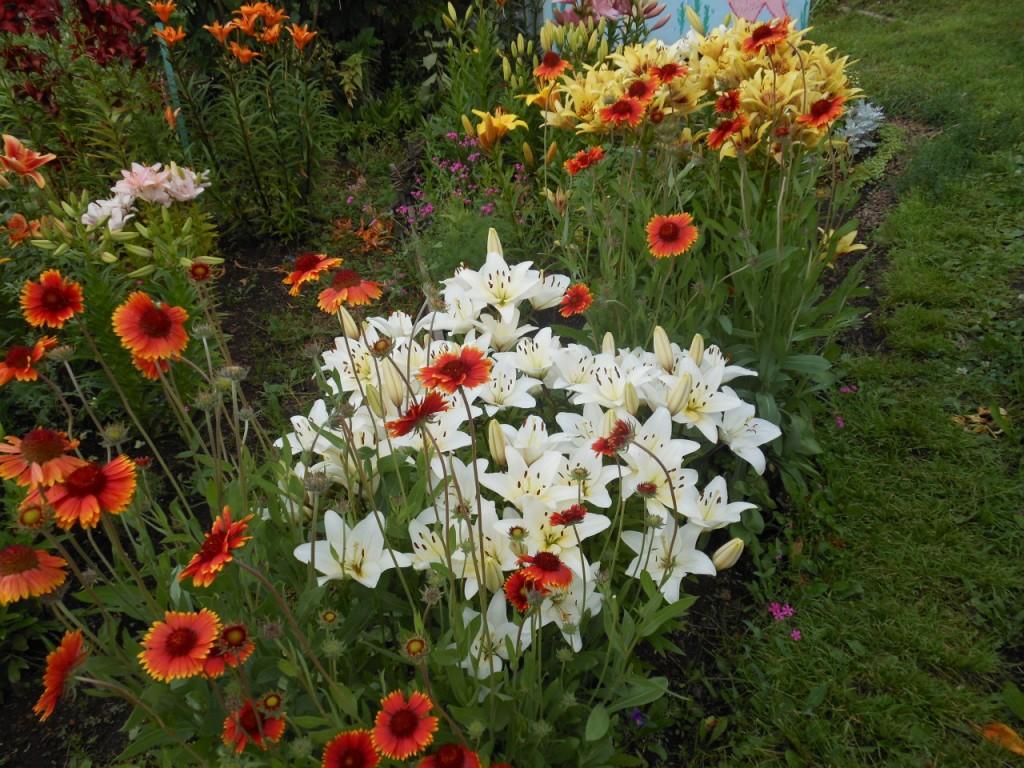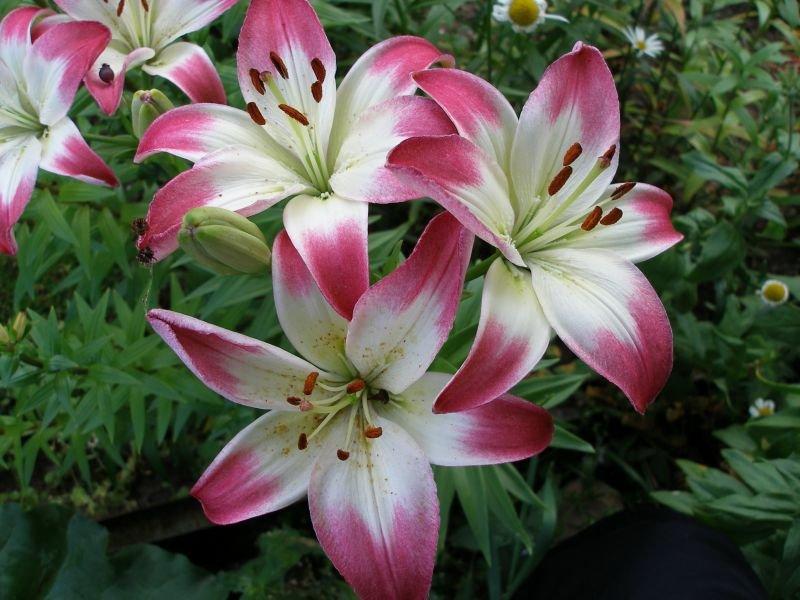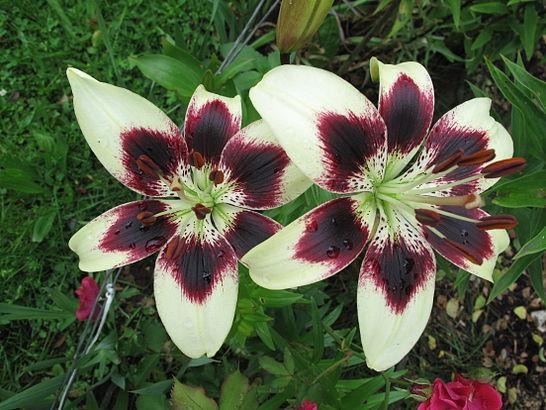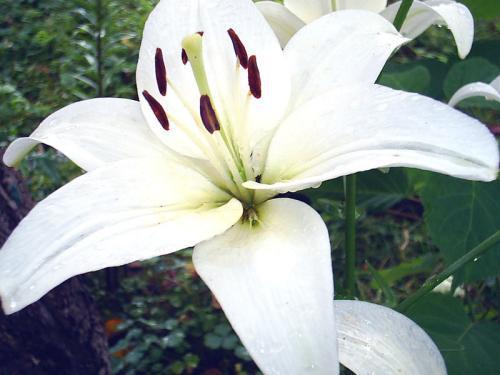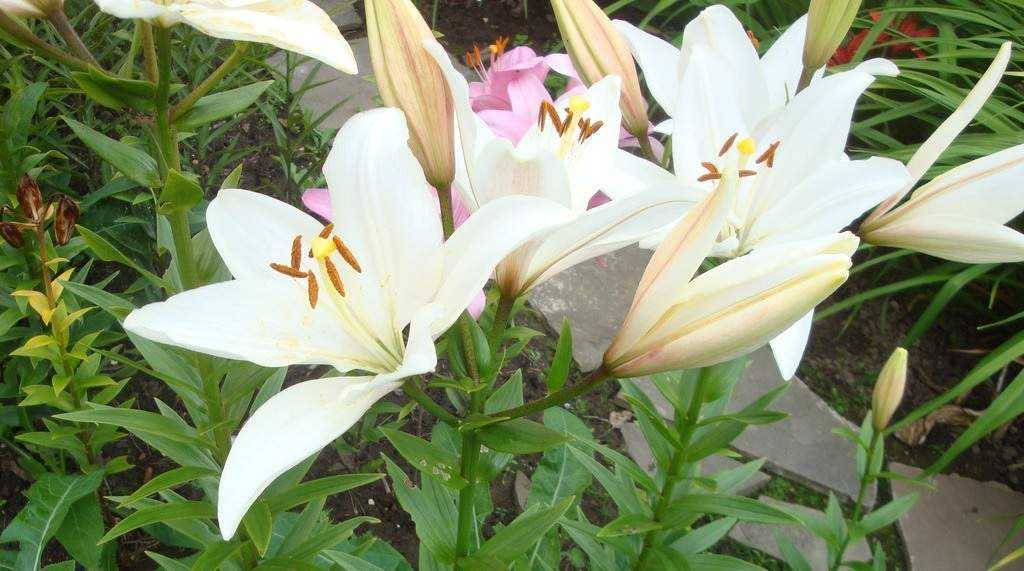Many gardeners face problems when choosing flowers to plant. Some of them prefer to plant lilies, as they are ideal for decorating the area. Before planting them, you need to familiarize yourself with the features of planting and caring for lilies in the open ground.
- Description and characteristics of lilies
- Main groups and popular varieties of lilies
- Asian
- Martagon
- Candidum
- Eastern
- The nuances of planting a flower
- Timing for planting lilies
- Planting bulbs in spring
- Autumn planting
- Selection and processing of planting material
- Choosing a landing site
- Soil preparation
- How to plant correctly
- Features of caring for an exotic plant in the garden
- Watering
- What to feed
- Care during flowering
- Trimming
- Protecting lilies from diseases and pests
- Preparing lilies for winter
- Transplantation and propagation
- Difficulties in growing lilies
- Features of agricultural technology in different regions of Russia
- Conclusion
Description and characteristics of lilies
To understand the main distinctive features of lilies, you need to read the description of this flower. The plant belongs to the group of perennial bulbous flowers. Moreover, its bulbs are very small, since their diameter is one centimeter. The shape of the bulbs can be ovoid or perfectly round, it all depends on the variety being grown. Their surface is covered with thin and loose scales.
During the growing process, the flower stem is covered with large oblong leaves. If the plant is properly cared for, it grows up to two meters. Some gardeners tie them up to prevent them from breaking due to the wind.
During flowering, inflorescences appear on the bushes, which, depending on the variety, can have an umbrella, cone-shaped or cylindrical shape.
They form 10-15 flowers, which bloom for 10-12 days. In the center of the flower bud are the stamens, around which are the petals. Each petal grows up to 5-8 centimeters in length.
Main groups and popular varieties of lilies
Today, hundreds of different varieties of lilies have been bred. Therefore, before planting flowers, you need to familiarize yourself with the most popular plant varieties.
Asian
People living in the northern regions prefer to plant Asiatic lily. This flower is resistant to low temperatures and tolerates many diseases without problems. The peculiarities of the plant include its small bulbs, which are painted white.Asian flowers can be burgundy, pink or bright red.
Among the advantages of the variety are:
- ease of care;
- early flowering;
- frost resistance;
- ease of propagation by scales.
Martagon
These garden plants grow up to 80-90 centimeters in height and therefore gardeners do not recommend planting them in compact flower beds. Martagon has several advantages that set it apart from other varieties of flowers:
- decorativeness;
- unpretentiousness to the soil;
- protection against bacterial diseases and insects;
- frost resistance.
Candidum
Hybrid varieties belonging to this group are bred on the basis of the royal snow-white lily. Such flowers are known not only for their beauty, but also for their pleasant aroma. Candidum flowers are white with a slight yellowish tint. Gardeners do not advise planting this type of lilies in northern regions, as they do not tolerate sudden drops in temperature.
Eastern
There are several popular oriental varieties that many gardeners grow:
- Askari. Determinate plant, growing up to one and a half meters. In summer, flowers with a yellow center and wavy white petals appear on the bush.
- Barbados. A distinctive feature of Barbados is its large flowers, the diameter of which is 20-25 centimeters. They are painted crimson.
- Anais. A tall lily, the height of which is 95-105 centimeters. In summer, inflorescences with crimson flowers, which are covered with dark patches, form on the bushes.
The nuances of planting a flower
Growing lilies begins with planting bulbs. It is necessary to figure out in advance when and how to plant them.
Timing for planting lilies
Some people don’t know when is the best time to plant flowers so that they grow normally.Experts advise doing this in spring and autumn.
Planting bulbs in spring
In spring, planting is carried out in early May, when frosts have completely ended. You should not plant bulbs in March or April.
Autumn planting
It is recommended to plant a lily in the fall in September, so that the root system becomes stronger before the onset of the first frost. Some gardeners plant them not in early autumn, but in August.
Selection and processing of planting material
The largest bulbs that contain the most nutritional components are selected for planting. Processing of selected bulbs is carried out in several stages:
- cleaning of dried husks;
- checking for damage;
- disinfection by soaking in a manganese solution.
Choosing a landing site
How the flowers will develop depends on the location chosen. Experienced gardeners do not recommend planting them in sunny areas, as in the sun the flowers quickly fade and lose their attractiveness.
It is recommended to choose a place in the garden that is reliably protected from the wind. Also, when choosing, you should pay attention to the plants that are planted in the neighborhood. Lilies grow best near peonies.
Soil preparation
The process of preparing the soil in which flowers will be grown consists of several stages:
- digging up the area to loosen the top layer of soil;
- arrangement of drainage, which is necessary to reduce soil moisture;
- application of mineral and organic fertilizers;
- adding chalk to reduce the acidity of the soil.
How to plant correctly
You need to figure out in advance how to plant flowers in the garden. To do this, a lily planting scheme is being studied. Before planting, you need to determine at what depth the bulbs are buried.It is recommended to plant them in holes about 10-15 centimeters deep. The distance between the bushes should be 25-30 centimeters.
After planting, all the bulbs are covered with soil, after which the soil is watered with water.
Features of caring for an exotic plant in the garden
If you don’t take care of the flowers in your dacha, they will gradually begin to die. Therefore, you need to familiarize yourself with the main nuances of growing lilies.
Watering
To prevent the flowers from fading, you will have to water them regularly. The procedure is carried out in the morning and evening, when there is no bright sunlight. When watering, carefully pour water under the root so that it does not fall on the leaves. For each bush you need to spend at least three liters of water.
What to feed
Lilies, like other flowers, need to be fertilized periodically. However, you should not add fresh cow manure to the soil, as it can slow down the development of the plant. Instead, it is better to use mineral fertilizers with wood ash and saltpeter. Feeding is done at least six times per season.
Care during flowering
When flowering, the plant consumes more moisture and nutrients. Therefore, during the period of formation and development of inflorescences, it is necessary to fertilize and water more often.
Trimming
Lilies are pruned after flowering has finished. It is recommended to wait until the last dried petals fall from the flowers and only then proceed with pruning. To carry out the procedure, use scissors or pruning shears.
Protecting lilies from diseases and pests
Planted lines may become sick during cultivation and die. To protect them from dangerous diseases, you need to periodically spray them with fungicidal preparations or Bordeaux mixture.Some experts recommend regularly treating the area with copper, which destroys pathogens.
Preparing lilies for winter
In order for lilies to survive the winter, it is necessary to prepare them for wintering in advance. In a few months, it is necessary to strengthen the root system so that it can cope with winter frosts. To do this, in early September and October, more potassium-phosphorus fertilizers are added to the soil. Flower growers advise feeding the soil with potash fertilizers and superphosphate.
To ensure better absorption of fertilizers, the area is periodically watered with heated water. In mid-October, watering the flower bed completely stops so that the bulbs do not begin to rot due to high humidity. In autumn, lilies are sprayed with copper sulfate 2-3 times to protect them from the development of fungal pathologies.
At the beginning of November, flower beds with planted lilies are insulated. Dried fallen leaves, wood twigs or sawdust are used as covering material. The shelter is removed in early or mid-April, when there is no frost.
Transplantation and propagation
There are five ways to propagate lilies, the features of which should be familiarized with:
- Separation of bulb nests. This method is considered the simplest, and therefore it is used quite often. 2-4 years after planting, small nests form on the bulbs. They are carefully disconnected from each other, after which the disconnected nests are planted in the ground.
- Planting daughter bulbs. Young bulbs form at the bottom of the stems. In the first half of September, they are carefully disconnected from the plant and planted in the soil to a depth of 6-8 centimeters. In the second half of spring, young seedlings will grow from them.
- Reproduction by scales.Many gardeners consider this method the most profitable, since at least one hundred scales are collected from each bulb. Separating scales should be done in late spring or autumn before frost.
- Planting bulbs. Small bud-shaped bulbs form on the stems of adult plants, which can be planted in the ground. Bulbs are collected and planted at the end of summer after flowering.
- Propagation by cuttings. When cutting cuttings, experts advise using stems. They are divided into several parts about ten centimeters long and planted in a flowerbed.
Difficulties in growing lilies
Some gardeners have certain difficulties when growing lilies:
- Death of plants after wintering. Most often, this problem occurs in people who did not insulate the flowerbed before the start of winter.
- Short flowering. Some gardeners complain that the flowers fade quickly. The duration of flowering may be shortened due to frequent soil moisture and lack of nutritional components.
- Drying. Often bushes dry out due to overheating of the root system. To prevent this from happening, tall plants are planted near the lilies to shade them.
Features of agricultural technology in different regions of Russia
It is no secret that climatic conditions differ in different regions of Russia, and therefore residents of the regions care for plants differently. For example, if a garden lily is grown in northern regions with severe winter frosts, then for the winter it will have to be dug out of the ground and planted in pots until it warms up. Gardeners from other regions do not need to dig up and replant the bulbs.
Flower growers living in the southern part of the country have to water their plants more often in the summer due to drought.In other regions there is no such problem, and therefore they moisten the soil less often. Experts do not advise residents of Siberia to plant lilies outside due to constant frosts. In such climatic conditions, it is better to grow them in greenhouses, where above-zero temperatures are maintained.
Conclusion
Some people think that growing lilies in open ground is easy, but this is not so. People who have never done this may have serious problems during the growing process. Therefore, before planting lilies, you need to familiarize yourself with the distinctive features of this flower and recommendations for caring for planted bushes.

